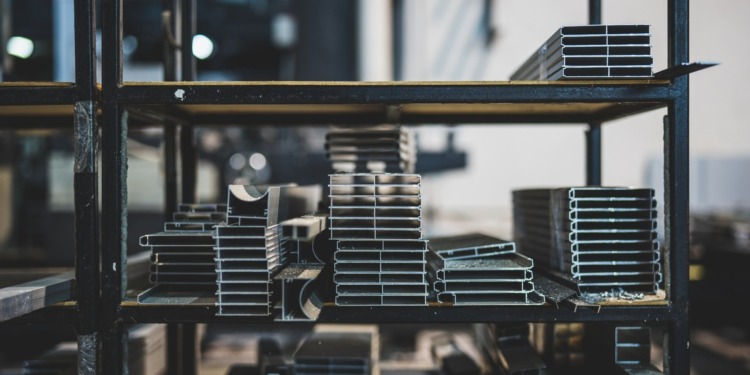Steel has played a huge role in human development for the past 4,000 years. Since the Iron Age, steel has been used for a variety of purposes, from medieval armor to modern railroads and infrastructure.
Today, the steel manufacturing process has become incredibly streamlined: the world produces enough steel to make an Eiffel Tower every three minutes, or 180,000 Eiffel Towers in a year. This adds up to about 240 kilograms of steel per person in the world, making steel the most commonly used metal in the world, with 1.864 billion metric tons of crude steel produced in 2020.
A factor of steel’s popularity is its infinite recyclability without any loss of quality. Steel can always be recycled, regardless of the quality or application. On average, new steel products contain 30% recycled steel.
The Production Process
Steel production involves several steps that transform raw materials into versatile alloys used in countless applications worldwide. The process typically begins with the extraction of iron ore from mines, where it is refined into iron through smelting, a process that involves heating the ore with carbon in a blast furnace.
This produces molten iron, which is then further processed in a basic oxygen furnace or an electric arc furnace to remove impurities and adjust its carbon content to create steel. During refining, various alloying elements may be added to enhance the steel’s properties, such as strength, corrosion resistance, or heat resistance. Once the desired composition is achieved, the molten steel is cast into solid shapes, either through continuous casting or ingot casting.
The formed steel is then subjected to various shaping and finishing processes, including rolling, forging, and heat treatment, to achieve the final desired product specifications. Throughout the entire process, stringent quality control measures are implemented to ensure the resulting steel meets the required standards for strength, durability, and consistency.
Related articles: How to Shift to, Grow, and Build Circular Economy | 5 Indian Sustainable Startups to Watch This Fall | Five Sustainable Startups From Bogotà | 4 Ways to Reduce Plastic Pollution | 5 Alternative Protein Startups to Watch | 9 Sustainable Startups From the Baltic Countries to Watch | Why We Need a Transformative Circular Economy | 5 Disruptive Circular Economy Startups to Watch
While steel itself is extremely circular, its production process tells a different story. Standard blast furnaces use coke (purified coal) to turn iron ore into molten iron at extremely high temperatures, a process that directly contributes to air pollution. Moreover, wastewater from the coking process is also highly toxic, containing compounds such as cyanide, sulfides, ammonium, and ammonia.
According to the International Energy Agency, approximately 1.4 tons of CO2 are emitted per ton of steel produced. With 1.875 billion tons of steel produced in 2019, at least 3.375 billion tons of CO2 were produced during the production processes.
Furthermore, steel products are responsible for 8% of the world’s CO2 emissions.
Where Limelight Steel Steps in
Startup Limelight Steel integrates its own process between ore mining and the casting process. This process, referred to as the “Limelight Process,” uses a laser furnace that contains laser diodes to illuminate and heat up iron ores, allowing for significant energy and emissions reductions in the smelting process.
Additionally, due to the high temperatures of laser heating, startup Limelight Steel can unlock thermal decomposition for cleaner divisions of ores into metal and oxygen. This process also significantly reduces hydrogen or fossil-based carbon emissions.
This laser furnace provides two unique advantages when compared to traditional green ironmaking practices: limiting hydrogen production and ore grade flexibility. Previous hydrogen-based furnaces can only use high-purity ores to produce solid iron. On the other hand, laser furnaces can remove impurities in their reactors, converting lower-grade ores into molten iron. This allows for further access to the world’s iron supply.
On its website, startup Limelight Steel highlights the importance of electrifying the steel-making process. The company hopes to leverage recent booms in laser technology that has the potential to eliminate 70% of the steel industry’s emissions. Furthermore, the California-based startup hopes to reduce energy usage within the steel industry by around 50% and reduce emissions by over 80%.
The Future of Steel: A More Circular Process
With steel playing a crucial role in a variety of industries, prices continue to rise. In fact, steel prices have doubled since 2023. Steel consumption and demand are projected to increase as the world continues to modernize, so a world of fossil-fuel-free steel must become a reality.
A further driver of sustainable steel production stems from altered carbon policies. For example, the EU’s Carbon Border Adjustment Mechanism (CBAM) increases the cost of imported finished steel, pushing countries to produce locally. By imposing costs on carbon-intensive imports, the EU is not only encouraging local production but also fostering a market for cleaner technologies. This policy could become a blueprint for other regions, creating a global shift towards greener manufacturing practices.
The focus on sustainable practices in the steel industry is not just about reducing emissions but also about securing a competitive edge in a rapidly changing global market. Limelight Steel, with its innovative approaches, is just one of the players in this evolving landscape. As they push the boundaries of traditional steelmaking, the industry sees a convergence of technological innovation and environmental stewardship.
Editor’s Note: The opinions expressed here by the authors are their own, not those of Impakter.com — Cover Photo Credit: ©tianya1223/Pixabay.









